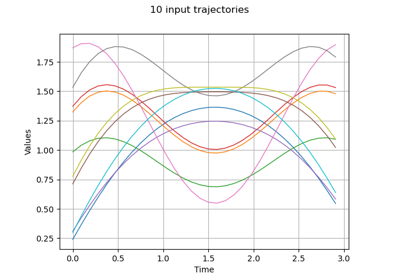FieldToPointFunction¶
- class FieldToPointFunction(*args)¶
Function mapping a field into a point.
- Parameters:
- inputMesh
Mesh The input mesh
- inputDimpositive int
Dimension of the input field values d
- outputDimpositive int
Dimension of the output vector d’
- inputMesh
Notes
Field to point functions act on fields to produce points:
with
a mesh of
.
A field is represented by a collection
of elements of
where
is a vertex of
and
the associated value in
.
The two first constructors build an object which evaluation operator is not defined (it throws a NotYetImplementedException). The instanciation of such an object is used to extract an actual
FieldToPointFunctionfrom aStudy.Examples
>>> import openturns as ot
Use the class
OpenTURNSPythonFieldToPointFunctionto create a function that acts on fields of input dimensionand input dimension
and returns their spatial mean vector of dimension
.
Using the class
OpenTURNSPythonFieldToPointFunctionallows one to define a persistent state between the evaluations of the function.>>> class FUNC(ot.OpenTURNSPythonFieldToPointFunction): ... def __init__(self): ... # first argument: ... mesh = ot.RegularGrid(0.0, 0.1, 11) ... super(FUNC, self).__init__(mesh, 2, 2) ... self.setInputDescription(['R', 'S']) ... self.setOutputDescription(['T', 'U']) ... def _exec(self, X): ... Xs = ot.Sample(X) ... Y = Xs.computeMean() ... return Y >>> F = FUNC()
Create the associated FieldToPointFunction:
>>> myFunc = ot.FieldToPointFunction(F)
It is also possible to create a FieldToPointFunction from a python function as follows:
>>> def myPyFunc(X): ... Xs = ot.Sample(X) ... Y = Xs.computeMean() ... return Y >>> inputDim = 2 >>> outputDim = 2 >>> mesh = ot.RegularGrid(0.0, 0.1, 11) >>> myFunc = ot.PythonFieldToPointFunction(mesh, inputDim, outputDim, myPyFunc)
Evaluate the function on a field:
>>> myField = ot.Field(mesh, ot.Normal(2).getSample(11)) >>> Y = myFunc(myField)
Methods
__call__(*args)Call self as a function.
Get the number of calls of the function.
Accessor to the object's name.
getId()Accessor to the object's id.
Accessor to the underlying implementation.
Get the description of the input field values.
Get the dimension of the input field values.
Get the mesh associated to the input domain.
getMarginal(*args)Get the marginal(s) at given indice(s).
getName()Accessor to the object's name.
Get the description of the output vector.
Get the dimension of the output vector.
setInputDescription(inputDescription)Set the description of the input field values.
setName(name)Accessor to the object's name.
setOutputDescription(outputDescription)Set the description of the output vector.
- __init__(*args)¶
- getCallsNumber()¶
Get the number of calls of the function.
- Returns:
- callsNumberint
Counts the number of times the function has been called since its creation.
- getClassName()¶
Accessor to the object’s name.
- Returns:
- class_namestr
The object class name (object.__class__.__name__).
- getId()¶
Accessor to the object’s id.
- Returns:
- idint
Internal unique identifier.
- getImplementation()¶
Accessor to the underlying implementation.
- Returns:
- implImplementation
A copy of the underlying implementation object.
- getInputDescription()¶
Get the description of the input field values.
- Returns:
- inputDescription
Description Description of the input field values.
- inputDescription
- getInputDimension()¶
Get the dimension of the input field values.
- Returns:
- dint
Dimension
of the input field values.
- getMarginal(*args)¶
Get the marginal(s) at given indice(s).
- Parameters:
- iint or list of ints,
Indice(s) of the marginal(s) to be extracted.
- iint or list of ints,
- Returns:
- function
FieldToPointFunction The initial function restricted to the concerned marginal(s) at the indice(s)
.
- function
- getName()¶
Accessor to the object’s name.
- Returns:
- namestr
The name of the object.
- getOutputDescription()¶
Get the description of the output vector.
- Returns:
- outputDescription
Description Description of the output vector.
- outputDescription
- getOutputDimension()¶
Get the dimension of the output vector.
- Returns:
- d’int
Dimension
of the output vector.
- setInputDescription(inputDescription)¶
Set the description of the input field values.
- Parameters:
- inputDescriptionsequence of str
Description of the input field values.
- setName(name)¶
Accessor to the object’s name.
- Parameters:
- namestr
The name of the object.
- setOutputDescription(outputDescription)¶
Set the description of the output vector.
- Parameters:
- outputDescriptionsequence of str
Description of the output vector.
Examples using the class¶

Estimate Sobol indices on a field to point function
 OpenTURNS
OpenTURNS